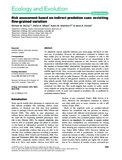Risk assessment based on indirect predation cues: revisiting fine-grained variation
Author
McCoy, Michael W.; Wheat, Stefan K.; Warkentin, Karen M.; Vonesh, James R.
Abstract
To adaptively express inducible defenses, prey must gauge risk based on indirect cues of predation. However, the information contained in indirect cues that enable prey to fine-tune their phenotypes to variation in risk is still unclear. In aquatic systems, research has focused on cue concentration as the key variable driving threat-sensitive responses to risk. However, while risk is measured as individuals killed per time, cue concentration may vary with either the number or biomass killed. Alternatively, fine-grained variation in cue, that is, frequency of cue pulses irrespective of concentration, may provide a more reliable signal of risk. Here, we present results from laboratory experiments that examine the relationship between red-eyed treefrog tadpole growth and total cue, cue per pulse, and cue pulse frequency. We also reanalyze an earlier study that examined the effect of fine-grained variation in predator cues on wood frog tadpole growth. Both studies show growth declines with increasing cue pulse frequency, even though individual pulses in high-frequency treatments contained very little cue. This result suggests that counter to earlier conclusions, tadpoles are using fine-grained variation in cue arising from the number of predation events to assess and respond to predation risk, as predicted by consumer–resource theory.
Subject
Date
2015-10
Citation:
APA:
McCoy, Michael W., & Wheat, Stefan K., & Warkentin, Karen M., & Vonesh, James R.. (October 2015).
Risk assessment based on indirect predation cues: revisiting fine-grained variation.
,
(),
-
. Retrieved from
http://hdl.handle.net/10342/5218
MLA:
McCoy, Michael W., and Wheat, Stefan K., and Warkentin, Karen M., and Vonesh, James R..
"Risk assessment based on indirect predation cues: revisiting fine-grained variation". .
. (),
October 2015.
June 29, 2024.
http://hdl.handle.net/10342/5218.
Chicago:
McCoy, Michael W. and Wheat, Stefan K. and Warkentin, Karen M. and Vonesh, James R.,
"Risk assessment based on indirect predation cues: revisiting fine-grained variation," , no.
(October 2015),
http://hdl.handle.net/10342/5218 (accessed
June 29, 2024).
AMA:
McCoy, Michael W., Wheat, Stefan K., Warkentin, Karen M., Vonesh, James R..
Risk assessment based on indirect predation cues: revisiting fine-grained variation. .
October 2015;
():
.
http://hdl.handle.net/10342/5218. Accessed
June 29, 2024.

